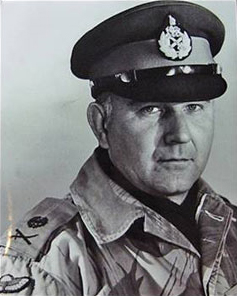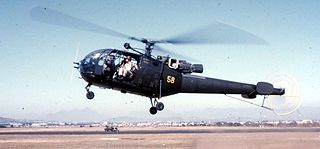
Hatfield House is a Grade I listed country house set in a large park, the Great Park, on the eastern side of the town of Hatfield, Hertfordshire, England. The present Jacobean house, a leading example of the prodigy house, was built in 1611 by Robert Cecil, 1st Earl of Salisbury and Chief Minister to King James I. It is a prime example of Jacobean architecture. The estate includes extensive grounds and surviving parts of an earlier palace. Queen Elizabeth's Oak is said the be the place that Elizabeth I was informed she had become queen. The house is currently the home of Robert Gascoyne-Cecil, 7th Marquess of Salisbury. It is open to the public.

The Rhodesian African Rifles (RAR) was a regiment of the Rhodesian Army. The ranks of the RAR were recruited from the black African population, although officers were generally from the white population. The regiment was formed in May 1940 in the British colony of Southern Rhodesia.

The 1st Battalion, Rhodesian Light Infantry (1RLI), commonly The Rhodesian Light Infantry (RLI), was a regiment formed in 1961 at Brady Barracks as a light infantry unit within the army of the Federation of Rhodesia and Nyasaland. Barely a year after its creation, it was relocated to Cranborne Barracks (Salisbury) where its headquarters remained for the rest of its existence. The Regiment became part of the Southern Rhodesian Army when the Federation dissolved at the start of 1964 and, later that year, reformed into a commando battalion.

The Rhodesian Special Air Service or Rhodesian SAS was the tier one special forces unit of the Rhodesian Army. It comprised:

The military history of Zimbabwe chronicles a vast time period and complex events from the dawn of history until the present time. It covers invasions of native peoples of Africa, encroachment by Europeans, and civil conflict.

Lieutenant General George Peter Walls was a Rhodesian soldier. He served as the Head of the Armed Forces of Rhodesia during the Rhodesian Bush War from 1977 until his exile from the country in 1980.

The Rhodesian Armoured Corps, nicknamed the "Black Devils" — was the only standing armoured cavalry battalion of the Rhodesian Army. During World War II, it took part in the Allied Spring 1945 offensive and the Battle of Monte Cassino as part of South Africa's 6th Armoured Division. The unit was among the first to enter a liberated Florence in July 1944. Prior to 1963, its crews were trained in the United Kingdom or Aden Colony and were known as the "Selous Scouts" under the Federation of Rhodesia and Nyasaland. After Rhodesia's Unilateral Declaration of Independence, maintaining the armoured vehicle fleet became a responsibility of the Rhodesian Light Infantry (RLI) until Major Bruce Rooken-Smith reactivated the former Rhodesian Armoured Car Regiment in 1972. During the Rhodesian Bush War, the regiment fought in several major campaigns and battles, particularly Operation Miracle in September 1979. It was superseded by the new Zimbabwe Armoured Corps between 1980 and 1981.

The Rhodesian Security Forces were the military forces of the Rhodesian government. The Rhodesian Security Forces consisted of a ground force, the Rhodesian Air Force, the British South Africa Police, and various personnel affiliated to the Rhodesian Ministry of Internal Affairs. Despite the impact of economic and diplomatic sanctions, Rhodesia was able to develop and maintain a potent and professional military capability.
There were a number of American volunteers in the Rhodesian Bush War who fought with the Rhodesian Security Forces. These men were nick-named the Crippled Eagles by author Robin Moore, who offered a house in Salisbury as a meeting place for the Americans who served in all units of the security forces, but never had their own unit. The name "Crippled Eagle" and their badge was meant to symbolise what they considered their abandonment by the US government. Robin Moore and Barbara Fuca tried to publish a book with the same title, but because of the political controversy the book was refused by publishers and appeared only in 1991, when it was published as The White Tribe.

John Alan Coey was a U.S. Marine who served in the Rhodesian Army as one of "the Crippled Eagles", a loosely organised group of U.S. expatriates fighting for the unrecognized government of Rhodesia during that country's Bush War. A devout Christian, vitriolic anti-communist, he was the first American fatality of the war. He moved to Rhodesia to join its army in 1972, the day after graduating from college in his home town of Columbus, Ohio, and served until he was killed in action in 1975. He kept a journal throughout his service that was posthumously published as A Martyr Speaks.
The MAP45 Armoured Personnel Carrier is a Rhodesian/Zimbabwean 4x4d heavy troop-carrying vehicle (TCV) first introduced in 1978 based on a Mercedes-Benz truck chassis. It remains in use with the Zimbabwe National Army.

The 1st Battalion, The Rhodesian Light Infantry, commonly the Rhodesian Light Infantry, was originally formed in 1961 as a regiment of the army of the Federation of Rhodesia and Nyasaland. Raised as a light infantry unit at Brady Barracks, Bulawayo in Southern Rhodesia, the Regiment served in the Rhodesian Bush War as part of the Rhodesian Security Forces between 1964 and 1979, from 1965 under the unrecognised governments of Rhodesia and latterly, during the second half of 1979, Zimbabwe Rhodesia. The RLI remained active during an interim period under British control and then, from April 1980, within the armed forces of Zimbabwe, before disbanding on 31 October 1980.

The 1st Battalion, The Rhodesian Light Infantry, commonly the Rhodesian Light Infantry, served in the Rhodesian Bush War as part of the Rhodesian Security Forces between 1964 and 1979, under the unrecognised government of Rhodesia following its 1965 Unilateral Declaration of Independence from Britain. During the second half of 1979 it fought for Zimbabwe Rhodesia, a black majority-ruled version of the same state which also failed to win international recognition. After an interim period under British control from December 1979 to April 1980, the RLI briefly remained active within the armed forces of Zimbabwe, but did not see action under this government. It disbanded on 31 October 1980.
The 1st Battalion, The Rhodesian Light Infantry, commonly the Rhodesian Light Infantry, served in the Rhodesian Bush War as part of the Rhodesian Security Forces between 1964 and 1979, under the unrecognised government of Rhodesia after its Unilateral Declaration of Independence from Britain on 11 November 1965. Latterly, during the second half of 1979, it fought for Zimbabwe Rhodesia, a reorganised version of Rhodesia under a black majority government which still went unrecognised. After an interim period under British control from December 1979 to April 1980, the RLI briefly remained active within the armed forces of the internationally recognised Republic of Zimbabwe, but did not see action under this government. It laid up its colours on 17 October 1980 and disbanded two weeks later.

7 Independent Company was a short-lived company of francophone volunteers in the Rhodesian Army during the Rhodesian Bush War. Numbering about 200 men at its peak, it was unique in the history of the Rhodesian Army as an exclusively expatriate unit. It existed between November 1977 and May 1978 as a company in the 1st Battalion, the Rhodesia Regiment, and served two counter-insurgency tours on Operation Hurricane in north-eastern Rhodesia.

Southern Rhodesia, then a self-governing colony of the United Kingdom, sent two military units to fight with the Commonwealth armed forces in the Malayan Emergency of 1948–60, which pitted the Commonwealth against the Malayan National Liberation Army (MNLA), the military arm of the Malayan Communist Party. For two years, starting in March 1951, white Southern Rhodesian volunteers made up "C" Squadron of the Special Air Service (SAS). The Rhodesian African Rifles, in which black rank-and-filers and warrant officers were led by white officers, then served in Malaya from 1956 to 1958.
Operation Nickel or the Wankie Campaign or the Wankie Battles was a military operation launched by the Rhodesian Security Forces on 1 August 1967 in response to the group of ZIPRA and Umkhonto we Sizwe (MK) fighters crossing the Zambezi River, which marked the Rhodesian-Zambian border. The operation was a success with only one of the cadres out of a force of seventy-nine making it back to Zambia.

On 23 December 1975, an Aérospatiale Alouette III helicopter of the South African Air Force carrying a two-man crew and four Rhodesian Army officers crashed near Cashel in Rhodesia after it collided with a hawser cable mid-flight. The accident dealt a severe blow to the Rhodesian Security Forces, then fighting bitterly against ZANLA and ZIPRA insurgents in the Rhodesian Bush War, for the officers involved were some of its best and would prove difficult to replace.

Colonel Lionel DyckSCZ (1944–2024), also referred to as Colonel Dyck, was a Zimbabwean soldier and security contractor. He was born in 1944 in Southern Rhodesia and served with the Rhodesian Army and then the Zimbabwe Defence Forces before founding and leading companies such as the Dyck Advisory Group (DAG) which provided specialist security services including anti-poaching, demining and counterinsurgency.
Lieutenant Colonel John Charles Wyatt Aust, commonly known as Charlie Aust was a Rhodesian military commander. He was born in Enkeldoorn, Southern Rhodesia and was the last commanding officer of the Rhodesian Light Infantry (RLI).
















